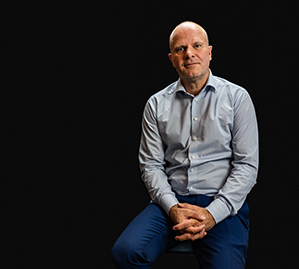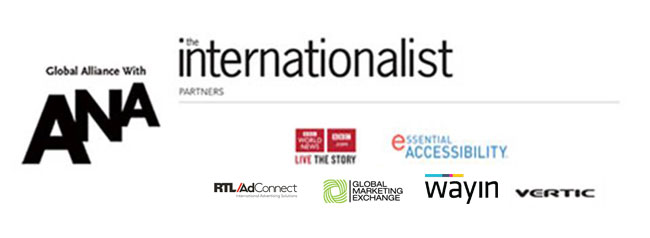

Vertic's Sebastian Jespersen
See the current issue
of The Internationalist magazine
Find out how to sponsor an issue of Trendsetters
|
|
If you have spotted a trend or given a recent presentation on a global issue, please tell use and don't forget a photo of yourself!

To submit to Trendsetters, contact me at: linkedin.com/in/deborah-malone-ab5897,
The Internationalist group on LinkedIn:
https://www.linkedin.com/groups/2560753/or at Twitter--@DMaloneIntl
TRENDSETTERS: Vertic's Sebastian Jespersen Outlines the Key to Creating Today's Corporate Digital Ecosystem
The Internationalist Trendsetters is written by Deborah Malone, founder of The Internationalist.
Sebastian Jespersen, CEO of Vertic and Author of The Battle for Share of Life™frequently clarifies that "we are no longer going online; we are living online." As a result, every company and every marketer are reimagining all facets of their digital ecosystems-- from websites to social networking, from digital media and communications to transaction processing that transcend the traditional functions of sales, marketing and customer service. Many are leveraging the latest technologies to build new processes, cultures, and experiences to compete in today's fast-changing digital marketplace.
"As the digital landscape continues to evolve and become more complex," says Jespersen, "many marketing organizations are increasingly focusing on shiny objects and social media platforms like Amazon, LinkedIn, and Facebook. This is in itself not a problem, but if the digital foundation is not in place and the majority of the user interactions between the brand and the customer are happening outside the company-owned platform. Therefore, corporations are sacrificing important customer insights, as well as the opportunity to create deeper relationships with their customers."
He adds, "As more of the buying journey, information gathering and interactions happen online, every brand needs a meaningful direct connection to its various stakeholders with an identity and tone of the voice that's distinct. Today, brands are created through their interactions with customers online.
As a result, the corporate website continues to be a critical core of the digital ecosystem, particularly when people want to know more about the companies they are buying from or interacting with. Today, consumers, investors, policy makers and potential employees want to understand not only what you do, but increasingly who you are."
According to Sebastian Jespersen, the best corporate websites can satisfy a marketer's need for relevant data, play a vital role in positioning brand values and ethics for all possible stakeholders, attract talent, inform the investment community, furnish essential information to policy-makers, and provide meaningful experiences in a digital-first world that goes far beyond a what's possible on standardized templates on third-party platforms.
As a result, Vertic has created the first global research that benchmarks the performance of corporate websites for leading corporations and brands by examining three criteria: Experience, Relevancy and Use of Technology. Called the Global Corporate Website Index, the rankings gauge a website's strengths and weaknesses in these three areas, so that individual scores can be understood on a comparative scale.
"Through the corporate website index, companies and corporations are able to benchmark their performance against industry peers and digital leaders and identify what they are doing well and what could be improved" says Jespersen.
Speaking last month at an Internationalist event with ANA as part of a NextGen Marketing Technology series, Jespersen outlined the trends he sees among the top-performing corporate websites, as well as which categories of business are setting new standards in exceeding customer expectations through the corporate digital journey.
Trends in Corporate Website Performance:
- Among the Top Five sites in the ranking, three are Business-to-Business Companies. "Some don't associate great marketing with b2b," says Jespersen. "However, when a company has a long sales cycle and customers need tremendous amounts of highly-specific information, one recognizes the essentiality of the website. Airbus is the #1 ranked website in the Index. Their site communicates to policymakers by underscoring their license to operate, nurtures their reputation and demonstrates how the company is living its purpose. You can post your purpose on Facebook, but you can't show how you are living it. Yet you can through your own website."
- The worst performing websites simply communicate what they do, rather than truly demonstrate who they are. According to Sebastian Jespersen, "It's also clear to see which of these companies are in the midst of an identity crisis. Interestingly, several Consumer Packaged Goods companies fall into this category. You'd assume, given their marketing spend, that they'd be expert in communicating. In this case, focusing on the consumer, rather than all stakeholders, can be a blind spot.
- Simplicity matters. "Our attention span is short," says Jespersen. "Some of the best websites have millions of pages, but they understand simplicity in design and also use data to customize the site through user behavior, geography or DNS-- making it easy for users fulfil their mission without giving up."
- Findability is a requirement. "Google has taught us to search with the expectation of finding meaningful results instantly. A corporate website should not only have more specific information than Google, but it should also know more about a user's intent. More corporate websites need to focus on their content architecture, so that search and the user journey becomes more relevant."
- Entangle the user in the journey. Jespersen emphasizes, "If I'm a current customer or I've been on the site six times, it's rude to be treated like a new user. Certainly, Amazon or Netflix takes repeat visits and preferences into consideration, so why wouldn't a corporation use similar technology to ensure that interactions get smarter over time?"
- Create a Distinct Experience. "The company DNA must come through in the website. Even if in the same field, two competitive companies are distinctly different to work for. Corporate culture matters and the best websites reflect the brand equity through tone, content and meaningful interactions."
More information will be soon be available on these details--rom an expanded white paper with CMO interviews to survey findings. Plus, the Index will be expanded to 500 corporations in 2020.
CRITERIA FOR WEBSITE ASSESSMENT
The key components for building a successful corporate website consist of understanding the user's intent, enabling them to find information on their own terms, and providing them with relevance to further their information journey. This can be accomplished through three elements on the site: user experience, relevancy, and the use of technology.
- User Experience: The UX and Design of the website enables the user to reach and consume the desired information as quickly and easily as possible. This is possible by applying an Intuitive Navigation System, Search, Circular User Flow, Consistency and Responsiveness.
- Relevancy: The relevancy of a website's experience is dictated by the content it provides. The role of the content on the website is to answer the user's information needs and build an emotional connection with them. This is done by creating a Customer/Stakeholder Decision Journey, User-Centric Language and Storytelling.
- Use of Technology: Technology should be used to power the user experience and work as a business enabler on the website. The use of technology should help website users make better informed critical decisions faster. This is achieved through the Technology Stack and understand Intent.
Building winning corporate websites is an ongoing commitment, and one of the most significant investments one can make in a company's digital marketing strategy. As a result, Vertic has made a commitment to update the index every 6 months, while adding more companies and industries with every edition.
